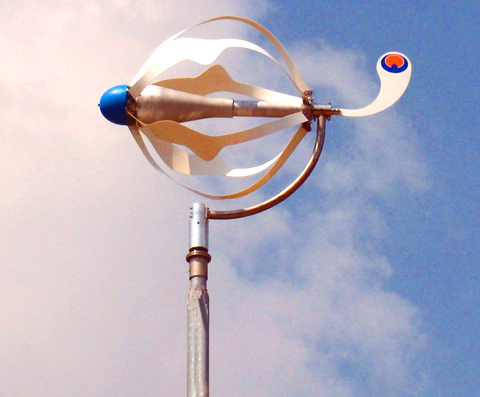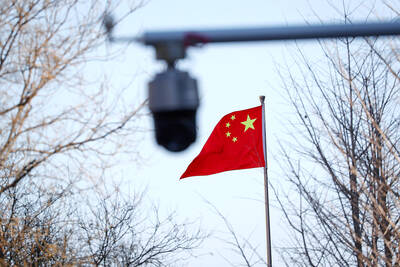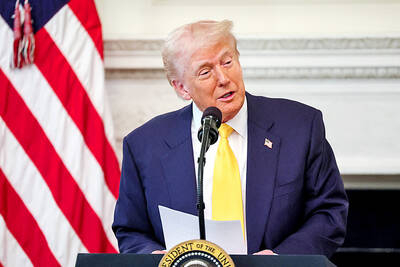Wind turbines typically spin from tall towers on hills and plains. But in these green times, some companies hope smaller turbines will soon rise above a more domestic spot: homes and garages.
The rooftop turbines send the electricity they generate straight on to the home’s circuit box. Then owners in a suitably wind-swept location can watch the needle on their electricity meter turn backward instead of forward, reducing their utility bills while using a renewable resource.
One new model, the Swift Wind Turbine, is designed to do its job quietly, said Dave Anderson, co-director of Renewable Devices in Edinburgh, which has partnered with Cascade Engineering in Grand Rapids, Michigan, to offer the turbine in the US.

PHOTO: NY TIMES NEWS SERVICE
“The noisiest it gets is 35 decibels,” roughly the sound of a quiet conversation, he said of the whir of the blades.
The turbine, which looks like a large wagon wheel, has a ring around its blades designed to diffuse noise and limit vibration.
“The air is steered toward the diffuser ring and dispersed, rather than leaving the blades with a ripping noise,” Anderson said.
The turbine costs US$10,000 to US$12,000 including installation, said Michael Ford, manager of the renewable energy business unit at Cascade Engineering. When the wind is blowing briskly at 48kph or more, it will generate 1.5 kilowatts of electrical power, he said. Enough, for instance, to run fifteen 100-watt light bulbs.
“You need a strong average wind speed,” he said, recommending that prospective customers make careful measurements before they buy.
“Don’t trust your memories about the wind power around your house,” he said. “People always remember when it’s windy,” but forget about the lulls.
Residents may measure wind speed with an anemometer, often available for rent, as well as by entering their address at the Swift Web site, which has listings of average wind speeds for localities.
The Swift turbine starts contributing electricity when the wind blows at 12kph; as the wind speed increases, so does turbine output, Ford said. Over a year, the energy output in windy locations should be roughly 2,000 kilowatt hours, he said, so that for homes that use 11,000 kilowatt hours in a year, for instance, electricity costs would be reduced by about 18 percent.
Kenneth Benefiel of Conklin, Michigan, bought a Swift turbine last fall, and had it installed on his 150-year-old post-and-beam barn, which serves as a garage and workroom, in time for Christmas.
“I had already switched to energy efficient appliances,” he said, reducing electricity usage by a third by buying a more efficient freezer and refrigerator and changing to fluorescent light bulbs. “The turbine was the next step.”
Benefiel, a retired carpenter, said that in the first five weeks after its installation, the turbine produced about 60 kilowatt hours of electricity, enough to power his house for about three days. The machine is quiet, but the old building on which it is mounted does its share of groaning in a stiff wind, he said.
So far, he is satisfied with his purchase.
“The turbine will conserve energy,” he said. “It’s making us more self-sufficient, and we’re doing our part to cut consumption. You have to think not only about saving money, but about saving resources.”
Turbines must be placed well above the roof to benefit from wind energy, said Sander Mertens in Voorburg, the Netherlands, who is a consultant in wind energy and author of Wind Energy in the Built Environment.
For a two-story building, for instance, the turbine should be at least 4.5m above the roof.
“Put it lower, and you will suffer from small wind speeds and a lot of turbulence,” he said.
Mertens offers a spreadsheet at his Internet site, www.ingreenious.com, that can be downloaded by people who want to do their own calculations for optimum turbine placement.
The American Wind Energy Association, a trade group in Washington, recommends placing the turbine at least 9m above anything in a 150m radius, said Ron Stimmel, a specialist in small wind turbines at the trade group American Wind Energy Association, in Washington.
Another small wind turbine for residences is the Energy Ball, to be sold in the US by Home Energy Americas, in McKinney, Texas. Robert Thompson, its chief executive, said he hoped to have the turbines on the market shortly. The Energy Ball is shaped like an eggbeater placed sideways, so that its blades turn around a horizontal axis. One model, the V100, will provide a maximum of 500 watts.

AT RISK: The council reiterated that people should seriously consider the necessity of visiting China, after Beijing passed 22 guidelines to punish ‘die-hard’ separatists The Mainland Affairs Council (MAC) has since Jan. 1 last year received 65 petitions regarding Taiwanese who were interrogated or detained in China, MAC Minister Chiu Chui-cheng (邱垂正) said yesterday. Fifty-two either went missing or had their personal freedoms restricted, with some put in criminal detention, while 13 were interrogated and temporarily detained, he said in a radio interview. On June 21 last year, China announced 22 guidelines to punish “die-hard Taiwanese independence separatists,” allowing Chinese courts to try people in absentia. The guidelines are uncivilized and inhumane, allowing Beijing to seize assets and issue the death penalty, with no regard for potential

STILL COMMITTED: The US opposes any forced change to the ‘status quo’ in the Strait, but also does not seek conflict, US Secretary of State Marco Rubio said US President Donald Trump’s administration released US$5.3 billion in previously frozen foreign aid, including US$870 million in security exemptions for programs in Taiwan, a list of exemptions reviewed by Reuters showed. Trump ordered a 90-day pause on foreign aid shortly after taking office on Jan. 20, halting funding for everything from programs that fight starvation and deadly diseases to providing shelters for millions of displaced people across the globe. US Secretary of State Marco Rubio, who has said that all foreign assistance must align with Trump’s “America First” priorities, issued waivers late last month on military aid to Israel and Egypt, the

‘UNITED FRONT’ FRONTS: Barring contact with Huaqiao and Jinan universities is needed to stop China targeting Taiwanese students, the education minister said Taiwan has blacklisted two Chinese universities from conducting academic exchange programs in the nation after reports that the institutes are arms of Beijing’s United Front Work Department, Minister of Education Cheng Ying-yao (鄭英耀) said in an exclusive interview with the Chinese-language Liberty Times (the Taipei Times’ sister paper) published yesterday. China’s Huaqiao University in Xiamen and Quanzhou, as well as Jinan University in Guangzhou, which have 600 and 1,500 Taiwanese on their rolls respectively, are under direct control of the Chinese government’s political warfare branch, Cheng said, citing reports by national security officials. A comprehensive ban on Taiwanese institutions collaborating or

France’s nuclear-powered aircraft carrier and accompanying warships were in the Philippines yesterday after holding combat drills with Philippine forces in the disputed South China Sea in a show of firepower that would likely antagonize China. The Charles de Gaulle on Friday docked at Subic Bay, a former US naval base northwest of Manila, for a break after more than two months of deployment in the Indo-Pacific region. The French carrier engaged with security allies for contingency readiness and to promote regional security, including with Philippine forces, navy ships and fighter jets. They held anti-submarine warfare drills and aerial combat training on Friday in